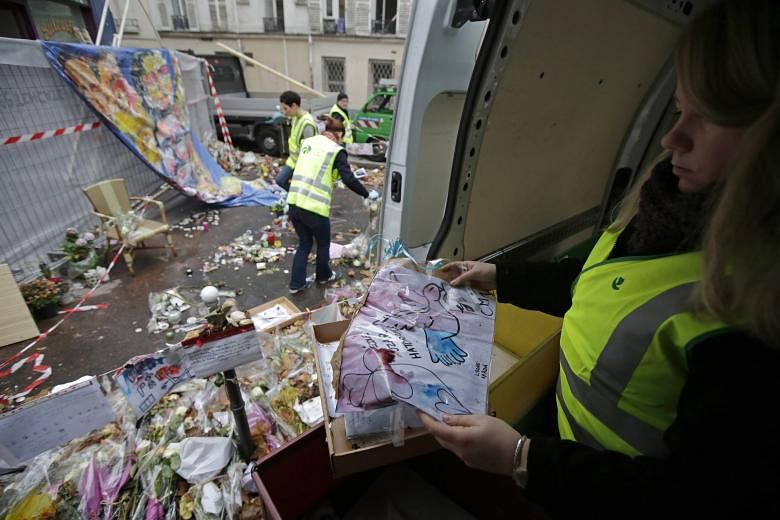PARIS • On a recent afternoon in the storage room of an imposing grey building in north-eastern Paris, Ms Mathilde Pintault cut open a sheet of clear plastic and pulled out a child's drawing, its colours blurred by water. She placed it carefully on special moisture-absorbing paper and put it on a shelf to dry.
A colleague, Mr Gerald Monpas, wiped mud and candle wax off another drawing. Under the muck was the image of a hand holding a glass of beer with La Belle Equipe written on it and a gun-wielding assailant drowning inside.
For Ms Pintault and Mr Monpas, both archivists for the city of Paris, this was not the usual fare of musty public records and old administrative documents.
Instead, they were sifting through some of the tens of thousands of letters, drawings and other tokens of grief that have been left at makeshift memorials after the Nov 13 attacks that killed 130 people. Assisted by the city's cleaning services and encouraged by groups of ordinary Parisians seeking to keep intact memories of the victims, they have already collected thousands of documents.
Memorials have become a common sight after tragic events worldwide. But when the wave of grief slowly subsides and life returns to normal, deciding what to do with the piles of objects left behind can be tricky.
Mr Guillaume Nahon, director of the Paris archives, said: "We need to leave some of the objects and, at the same time, we need to make room for the sidewalk, sometimes even the road, so that life can go on."
"It's a day-to-day process and a contradictory one too because these memorials are supposed to be ephemeral, but people still need a place to mourn for now," he said, standing near the Belle Equipe cafe, where 19 people were killed.
After the Sept 11 attacks in New York, collectors there had to navigate the same difficult and ill-defined line between the moment that impromptu memorials were no longer growing organically and the moment that messages, flowers, origami cranes as well as other mementos became refuse.
"You didn't want to interrupt the life of a memorial while it was still in service," said Mr Mark Schaming, director of the New York State Museum in Albany. "On the other hand, you didn't want to see it destroyed."
The attacks came less than a year after three gunmen killed 17 people, including at the offices of the satirical newspaper Charlie Hebdo and at a kosher supermarket, in January. Those places became temporary sites of mourning, but none of the objects left there was archived, although the library at Harvard University recently began an initiative to collect such material.
This time, the city of Paris quickly mounted an effort to archive the material from Nov 13, which will prove valuable to sociologists and historians.
Ms Alice Greenwald, director of the National September 11 Memorial and Museum in New York, said sentiments at impromptu memorials after that attack ran the gamut. This is evident in the "Schuster scroll", named for student Jordan Schuster, who taped down a piece of butcher paper at Union Square in Manhattan immediately after the attack on which people could write.
"Every possible emotion was reflected there," Ms Greenwald said.
"Never forget. Immediate anger at politicians and whoever was responsible. Patriotic responses."
Sociologist Gerome Truc, who is publishing a book on reactions to some of the last decade's deadliest terrorist attacks, said the letters and notes at spontaneous memorials often countered prevailing media narratives or political discourse.
"What you always find, in all the attacks I've studied, is that people invoke love and peace," he said, adding that former United States president George W. Bush and French President Francois Hollande had struck much more martial tones after attacks. "If you don't have these documents, you completely lose access to that dimension of things."
Some Parisians are calling for a permanent memorial or, at the very least, a website indexing some of the messages.
Mr Nahon, the archives director, said he was surprised by the interest in preserving the tributes.
"As an archivist, I usually complain about people's indifference to the meaning of our work," he said. "It is the first time I am seeing such a need coming from ordinary people."
NEW YORK TIMES

